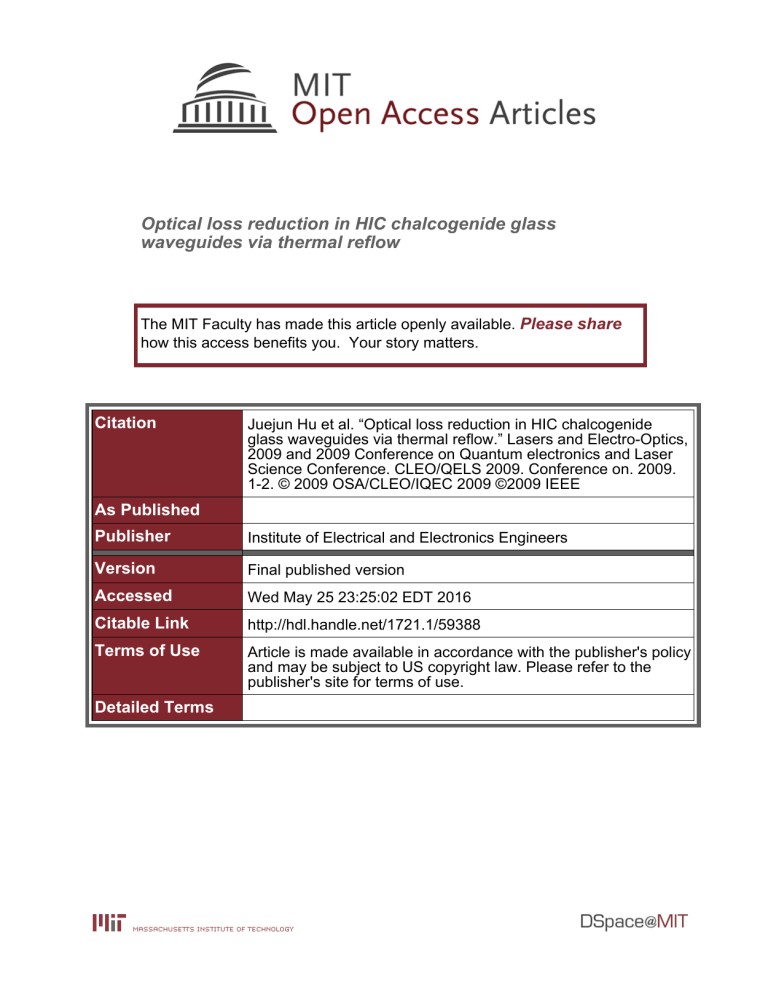Optical loss reduction in HIC chalcogenide glass waveguides via thermal reflow

Optical loss reduction in HIC chalcogenide glass waveguides via thermal reflow
The MIT Faculty has made this article openly available.
Please share
how this access benefits you. Your story matters.
Citation
As Published
Publisher
Version
Accessed
Citable Link
Terms of Use
Detailed Terms
Juejun Hu et al. “Optical loss reduction in HIC chalcogenide glass waveguides via thermal reflow.” Lasers and Electro-Optics,
2009 and 2009 Conference on Quantum electronics and Laser
Science Conference. CLEO/QELS 2009. Conference on. 2009.
1-2. © 2009 OSA/CLEO/IQEC 2009 ©2009 IEEE
Institute of Electrical and Electronics Engineers
Final published version
Wed May 25 23:25:02 EDT 2016 http://hdl.handle.net/1721.1/59388
Article is made available in accordance with the publisher's policy and may be subject to US copyright law. Please refer to the publisher's site for terms of use.
© 2009 OSA/CLEO/IQEC 2009
CTuO3.pdf
Optical loss reduction in HIC chalcogenide glass waveguides via thermal reflow
Juejun Hu, Ning-Ning Feng, Anu Agarwal, Lionel Kimerling
Microphotonics Center, Massachusetts Institute of Technology, Cambridge, MA 02139, USA hujuejun@mit.edu
, anu@mit.edu
Nathan Carlie, Laeticia Petit, Kathleen Richardson
School of Materials Science & Engineering, COMSET, Clemson University, Clemson, SC 29634, USA
Abstract: A rapid thermal reflow technique is applied to high-index-contrast, sub-micron waveguides in As
2
S
3
chalcogenide glass to reduce sidewall roughness and associated optical scattering loss. Up to 50% optical loss reduction after reflow treatment is achieved.
© 2009 Optical Society of America
OCIS codes: (160.2750) Glass and other amorphous materials; (130.3120) Integrated optics devices; (230.7390)
Waveguides, planar; (240.5770) Roughness.
1. Introduction
Chalcogenide glasses (ChG’s) have recently emerged as a promising material candidate for high-index-contrast
(HIC) photonic devices, featuring almost unlimited capacity for composition and property tailoring, wide infrared transparency, and high Kerr nonlinearity accompanied with low two photon absorption (TPA) [1]. However, despite the tight optical confinement in HIC waveguides and the ensuing integration benefits, HIC waveguides typically suffer high propagation loss, mainly due to increased optical scattering from sidewall roughness, which scales with the square of refractive index contrast [2]. We showed that optical scattering arising from sidewall roughness is the dominant source of optical loss in HIC chalcogenide strip waveguides [3], and such high scattering loss is a major hurdle to performance improvement of HIC photonic devices in chalcogenide glass.
In this letter, we present rapid thermal reflow as an effective approach for sidewall roughness and optical loss reduction in HIC chalcogenide waveguide devices. In analogy to a fiber drawing process, the action of surface tension leads to elimination of roughness and hence negligible scattering loss. Thermal reflow has been shown to effectively decrease optical loss in silica glass [4]; and this is the first report of applying the reflow technique to chalcogenide glasses to the best of our knowledge. Compared to silica glass reflow process, chalcogenide glass reflow does not require thermal processing at elevated temperature given the lower softening temperature of chalcogenides. Such a tolerant thermal budget, compatible with CMOS backend processes, and imposing minimal adverse effects on other on-chip devices, is particularly advantageous for electronic and photonic integration.
2. Device fabrication and characterization
The chalcogenide glass bulk preparation and film deposition process are described elsewhere [5, 6]. Strip waveguides with a width of 800 nm and a height of 400 nm in thermally evaporated As
2
S
3
film (n = 2.37) are patterned via lift-off in this study. The entire patterning process has been carried out on a 500 nm CMOS line [3].
Thermal reflow of the as-patterned waveguide devices is carried out at different temperatures (± 5 ºC) on a preheated hotplate in a nitrogen filled glove box (oxygen and water vapor impurity < 1 ppm). After heat treatment, the samples are immediately transferred onto an aluminum heat sink held at room temperature to minimize dwelling time at intermediate temperatures. Before optical characterization, a 3 µm thick layer of SU8 polymer is spin-coated onto the waveguides to prevent oxidation. Cavity quality factors (Q-factors) of racetrack micro-resonators, comprising As
2
S
3
strip waveguides with a bending radius of 50 µm, are measured using a fiber end-fire technique.
The corresponding optical loss in the waveguides is calculated based on critically coupled resonator Q factors.
3. Results and discussion
Figure 1 shows the surface morphology of chalcogenide glass waveguides (a) before and (b) after reflow at 230 ºC for 15 s. The sidewall roughness is significantly reduced after reflow, and the waveguide cross-sectional geometry is modified towards a dome shape due to surface tension. RMS sidewall roughness values of As
2
S
3
waveguides plotted in Figure 2a confirm that roughness decreases as reflow temperature increases, given the reduced viscosity of As
2
S
3
978-1-55752-869-8/09/$25.00 ©2009 IEEE
© 2009 OSA/CLEO/IQEC 2009
CTuO3.pdf glass at higher temperature. Power spectral density functions of waveguide sidewall roughness are shown in Fig. 2b.
Generally the roughness amplitude diminishes with the roughness wavelength, a trend observed in waveguides fabricated in other material systems [7]. Further, roughness with smaller spatial wavelength exhibits a more significant amplitude reduction. Such an observation will be discussed and consistently explained within the framework of a kinetic theory.
(b)
Fig. 1. Surface morphology of As
2
S
3
waveguides: (a) as-patterned; (b) reflowed at 230 ºC for 15 s; and (b) reflowed at 240 ºC for 15 s.
Figure 2c plots the transmission loss in As
2
S
3
waveguides after reflow treatment at different temperatures. The optical loss decrease after 15 s reflow from 210 ºC to 230 ºC is consistent with the trend of sidewall roughness smoothing, and thus can be associated with the scattering loss reduction. However, despite the continuing trend of roughness reduction at increased reflow temperature, optical loss in As
2
S
3
waveguides sharply increases to ~ (20 ± 6) dB/cm after 15 s reflow at 240 ºC. Based on material and device characterization results, we attribute the loss increase to the partial evaporation of As
2
S of optical loss in As
3
glass, which leads to waveguide thickness reduction and hence increased bending loss and modal mismatch loss between the straight and bent sections in a racetrack resonator. The evolution
2
S
3
is also investigated using waveguide modal analysis and good agreement between simulation and measurement is confirmed.
(a) (b) (c)
Fig. 2. (a) RMS waveguide sidewall roughness; (b) waveguide roughness amplitude as a function of roughness wavelength and (c) optical transmission loss in racetrack resonators for different reflow temperatures.
References
[1] V. Ta'eed, N. Baker, L. Fu, K. Finsterbusch, M. Lamont, D. Moss, H. Nguyen, B. Eggleton, D. Choi, S. Madden, and B. Luther-Davies,
Opt. Express 15 , 9205-9221 (2007).
[2] T. Barwicz and H. Haus, J. Lightwave Technol. 23, 2719 (2005).
[3] J. Hu, V. Tarasov, N. Carlie, N. Feng, L. Petit, A. Agarwal, K. Richardson, and L. Kimerling, Opt. Express 15 , 11798 (2007).
[4] D. Armani, T. Kippenberg, S. Spillane, and K. Vahala, Nature 421 , 925 (2003).
[5] W. Li, S. Seal, C. Rivero, C. Lopez, K. Richardson, A. Pope, A. Schulte, S. Myneni, H. Jain, K. Antoine, and A. Miller, “Role of S/Se ratio in chemical bonding of As–S–Se glasses investigated by Raman, x-ray photoelectron, and extended x-ray absorption fine structure spectroscopies,” J. Appl. Phys. 98 , 053503 (2005).
[6] J. Hu, V. Tarasov, N. Carlie, L. Petit, A. Agarwal, K. Richardson, and L. Kimerling, “Fabrication and Testing of Planar Chalcogenide
Waveguide Integrated Microfluidic Sensor,” Opt. Express 15 , 2307 (2007).
[7] D. Sparacin, K. Wada, and L. Kimerling, Integrated Photonics Research, A. Sawchuk, ed., Vol. 91 of OSA Trends in Optics and Photonics
(Optical Society of America, 2003), paper ITuC4.





